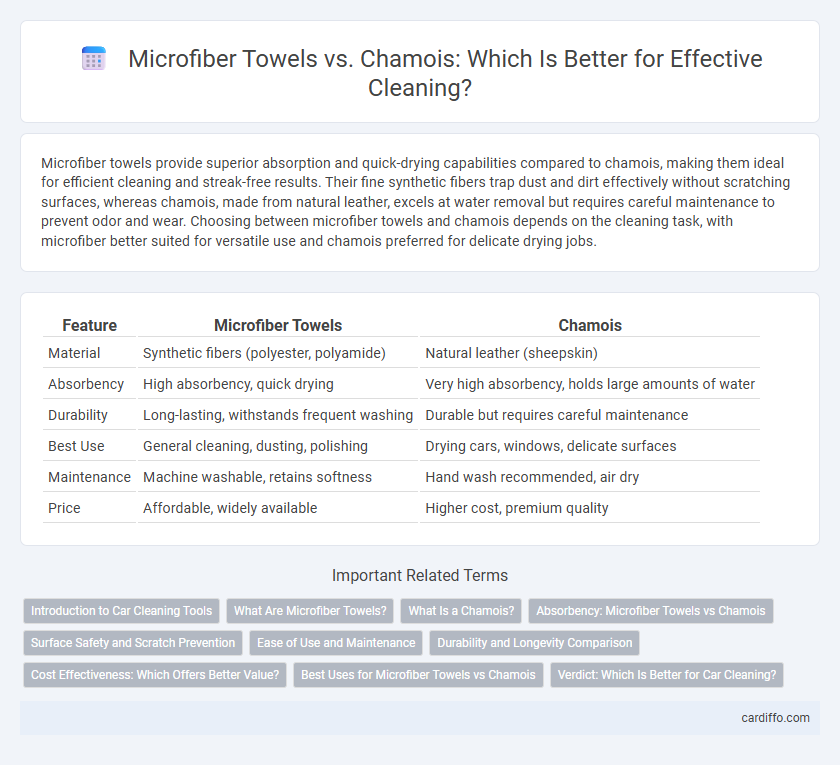Microfiber towels provide superior absorption and quick-drying capabilities compared to chamois, making them ideal for efficient cleaning and streak-free results. Their fine synthetic fibers trap dust and dirt effectively without scratching surfaces, whereas chamois, made from natural leather, excels at water removal but requires careful maintenance to prevent odor and wear. Choosing between microfiber towels and chamois depends on the cleaning task, with microfiber better suited for versatile use and chamois preferred for delicate drying jobs.
Table of Comparison
| Feature | Microfiber Towels | Chamois |
|---|---|---|
| Material | Synthetic fibers (polyester, polyamide) | Natural leather (sheepskin) |
| Absorbency | High absorbency, quick drying | Very high absorbency, holds large amounts of water |
| Durability | Long-lasting, withstands frequent washing | Durable but requires careful maintenance |
| Best Use | General cleaning, dusting, polishing | Drying cars, windows, delicate surfaces |
| Maintenance | Machine washable, retains softness | Hand wash recommended, air dry |
| Price | Affordable, widely available | Higher cost, premium quality |
Introduction to Car Cleaning Tools
Microfiber towels are highly effective car cleaning tools due to their dense, split fibers that trap dirt and absorb liquids without scratching surfaces. Chamois, made from soft leather, excel at drying cars quickly while leaving a streak-free finish but require careful maintenance to prevent odors. Both tools are essential for car enthusiasts seeking optimal cleaning performance and surface protection.
What Are Microfiber Towels?
Microfiber towels are made from ultra-fine synthetic fibers, typically a blend of polyester and polyamide, designed to trap dirt, dust, and moisture more effectively than traditional fabrics. These towels offer superior absorbency and quick drying properties, making them ideal for cleaning delicate surfaces without scratching. Commonly used in automotive detailing and household cleaning, microfiber towels provide a lint-free finish and enhanced durability compared to natural materials like chamois.
What Is a Chamois?
A chamois is a soft, absorbent leather cloth traditionally made from the hide of the chamois antelope or sheepskin, widely used for drying and polishing surfaces without scratching. Its natural fibers provide excellent water absorption and streak-free finishes, making it ideal for automotive detailing and delicate cleaning tasks. Unlike synthetic microfiber towels, chamois requires proper care to maintain flexibility and prevent hardening over time.
Absorbency: Microfiber Towels vs Chamois
Microfiber towels offer superior absorbency compared to chamois, with the ability to hold up to seven times their weight in water due to their dense synthetic fibers. Chamois, made from natural leather, absorbs moisture efficiently but tends to saturate faster and requires more frequent wringing. For high-absorbency cleaning tasks, microfiber towels provide better performance and faster drying times.
Surface Safety and Scratch Prevention
Microfiber towels provide superior surface safety due to their ultra-fine fibers that effectively trap dirt without causing scratches, making them ideal for delicate surfaces like automotive paint and glass. Chamois, though soft and absorbent, can sometimes harbor grit that may scratch surfaces if not properly maintained. Opting for microfiber towels significantly reduces the risk of micro-scratches during cleaning, ensuring a safer and more effective scratch prevention solution.
Ease of Use and Maintenance
Microfiber towels offer superior ease of use due to their lightweight, non-abrasive texture that quickly absorbs water and dries surfaces without leaving streaks. Chamois require proper conditioning and regular wringing to maintain softness and effectiveness, making them less convenient for everyday cleaning tasks. Maintenance of microfiber towels involves simple machine washing without fabric softeners, ensuring long-lasting performance and resistance to odors and bacteria.
Durability and Longevity Comparison
Microfiber towels exhibit superior durability and longevity compared to chamois due to their resilient synthetic fibers that withstand frequent washing without losing effectiveness. Chamois, made from natural leather, tend to degrade faster, becoming brittle and less absorbent over time with extensive use. Choosing microfiber towels ensures a longer lifespan and sustained cleaning performance, making them more cost-effective for regular cleaning tasks.
Cost Effectiveness: Which Offers Better Value?
Microfiber towels provide better cost effectiveness due to their durability and reusability, often lasting through hundreds of washes without losing absorbency or softness. Chamois towels, while highly absorbent and gentle on surfaces, tend to require more frequent replacement and specialized care, increasing long-term costs. Investing in high-quality microfiber towels delivers superior value by combining affordability, longevity, and efficient cleaning performance.
Best Uses for Microfiber Towels vs Chamois
Microfiber towels excel at trapping dust, dirt, and moisture, making them ideal for cleaning glass, electronics, and polishing surfaces without leaving lint or streaks. Chamois leather is highly absorbent and gentle, perfect for drying cars, boats, and delicate surfaces while reducing water spots. For detailed cleaning and streak-free finishes, microfiber towels outperform chamois, whereas chamois is preferred for quick and effective water removal on large surfaces.
Verdict: Which Is Better for Car Cleaning?
Microfiber towels outperform chamois in car cleaning due to superior absorbency, durability, and lint-free results, ensuring a streak-free finish. Microfiber's synthetic fibers trap dirt and moisture more effectively, reducing the risk of scratching delicate paint surfaces compared to the natural leather material of chamois. For consistent, efficient cleaning and protection of automotive finishes, microfiber towels are the preferred choice among professionals and enthusiasts.
Microfiber towels vs Chamois Infographic

 cardiffo.com
cardiffo.com